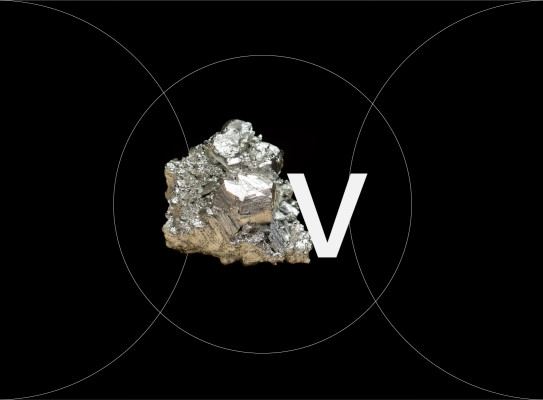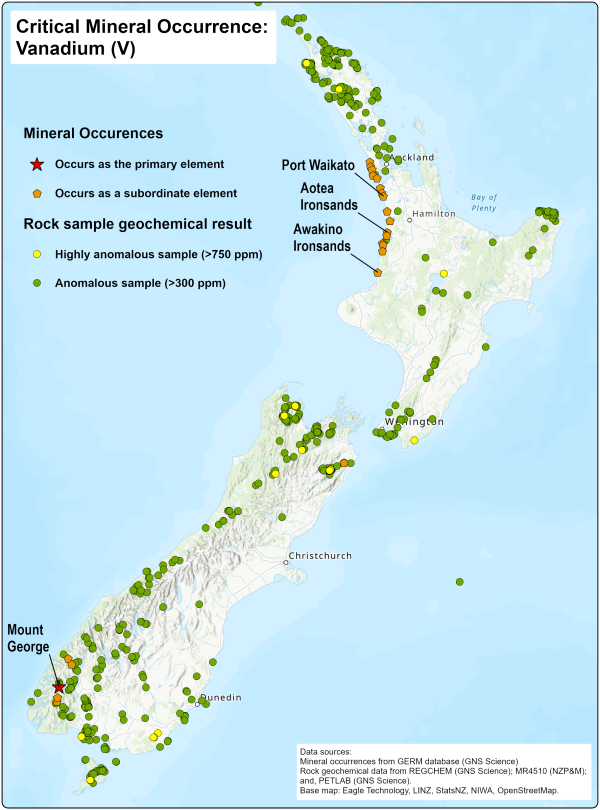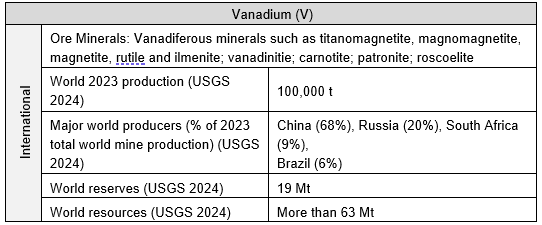Vanadium

Vanadium (V) is a strategic metal essential for modern industry, energy storage, and advanced materials. It is valued for its ability to enhance strength, corrosion resistance, and energy efficiency across multiple applications.
Vanadium in New Zealand
Vanadium occurs in association with iron and titanium in placer titanomagnetite deposits of the west coast of the North Island and magnetite-ilmenite deposits in Fiordland.
A vanadium-rich slag is produced by BHP New Zealand Steel during steel manufacture at the Glenbrook Steel mill. Currently 12,000 t/yr is produced and exported to China, representing 10% of the world’s vanadium production. The slag is processed to enrich (V₂O₅) with the product used to make ferrovanadium, which is used as an additive in steel.

Geology and Exploration
Vanadium is primarily extracted from:
- Titanium-vanadium magnetite deposits (e.g., layered mafic intrusions).
- Shale-hosted vanadium deposits in organic-rich black shales.
- Secondary sources like steel slag and petroleum residues.
Why Vanadium is Critical
- Essential for strong, lightweight, and durable materials in construction, aerospace, and defence.
- Enables efficient renewable energy storage, critical for reducing reliance on fossil fuels.
- Increasing global demand, with supply risks due to limited primary producers (China, Russia, South Africa).
Vanadium’s role in steel, energy storage, and future technologies makes it a vital element for the transition to a low-carbon economy and a strategic mineral for global industries.
Key Uses of Vanadium
High-Strength Steels
- Over 90% of vanadium is used as an alloying element in steel production, forming vanadium carbide (VC), which increases strength, toughness, and wear resistance.
- Used in high-strength low-alloy (HSLA) steels for construction, bridges, pipelines, and vehicles.
- Essential for aerospace alloys, improving heat resistance and durability in jet engines and space applications.
Energy Storage and Vanadium Redox Flow Batteries (VRFBs)
- VRFBs provide long-duration, high-capacity energy storage, ideal for renewable energy integration (e.g., solar and wind power).
- Unlike lithium-ion batteries, VRFBs have virtually unlimited cycle life, making them a key technology for grid-scale energy storage.
Chemical and Catalytic Applications
- Vanadium pentoxide (V₂O₅) is used as a catalyst in the production of sulfuric acid, a vital industrial chemical.
- Plays a role in petrochemical refining by removing impurities in crude oil processing.
Emerging Technologies
- Used in vanadium-based superconductors and next-generation quantum materials.
- Research into vanadium alloys for fusion energy reactors is ongoing due to its radiation resistance.

Additional Reading
Brathwaite RL, Pirajno F. 1993. Metallogenic map of New Zealand. Lower Hutt (NZ): Institute of Geological and Nuclear Sciences. 215 p. (Institute of Geological & Nuclear Sciences monograph; 3).
Williams GJ. 1974. Economic geology of New Zealand. Rev. ed. Victoria (AU): Australasian Institute of Mining and Metallurgy. 490 p. (Australasian Institute of Mining and Metallurgy monograph series; 4).